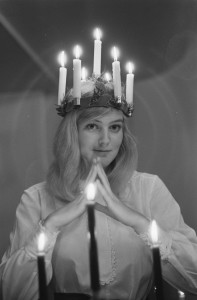Come December 13 we are but eight days from the midwinter solstice in the Northern Hemisphere and now enters another of the light bearers, and a gift bearer, as well. It is Santa Lucia, St. Lucy, patron saint of eyesight. Lucia, a name derived from the Latin lux and lucis: light. The nights grow increasingly darker on our solstice approach. Santa Lucia breaks the night darkness with light that shines from her head, at least in the Swedish tradition.
The historical Lucia was from Sicily. She is said to have intervened in a famine in Sicily in the 16th century when a flotilla of grain mysteriously arrived in port on her feast day. Rather than take the time to mill the wheat into flour, the hungry people fed themselves on boiled wheat grains, and to this day, whole grain wheat finds its way into traditional Italian foods for Santa Lucia’s Day. But Lucia’s following is equally strong in Sweden, oddly enough. Some say that she intervened in a famine there, too, though I am not sure about that. What is obvious, though, is that life along the Arctic Circle on the approach to midwinter is dark indeed, and here is a saint who’s very name calls down light.
Here is the best song you can listen to today. It is an old Neapolitan melody about Santa Lucia, but it is in Swedish. I love this melding of cultures and celebration. In Italian, Lucia is pronounced with a “ch” (loo-chee-a) while in Swedish, the C is soft (loo-see-a). The song you’re listening to, if you’re listening to it (and I hope you are) is from a procession in Sweden of young girls dressed in white and young boys, called star boys, also dressed in white, carrying stars on tall poles. Somewhere amongst them is the Lucia, wearing a wreath of lit candles upon her head. Such a beautiful song and such a beautiful sight. In this time of still increasing darkness, we welcome the light, we welcome the beauty, we welcome the harmony and know in our hearts that this is right and this is good.
Image: “Miss Lucia,” a photograph from the National Archive of the Netherlands. Miss Lucia is Nannette van Viet-Dapper, photographed on December 9, 1967. Perhaps some Swedish traditions have emerged to the south, as well. [Public domain] via Wikimedia Commons.

Oh how your wondrous posts fill our hearts! As we listened to the beautiful Santa Lucia, my husband remembered his grandfather, Carmello Lemmo, who loved that song. He came from Italy many years ago and though he loved America, he missed his homeland. And I remembered my Irish grandmother singing the song in our kitchen as she cooked dinner and I practiced it on my accordion across the hall in my bedroom. She was a giant light in my life. Your posts always fill us …with hope, Joy nod memory. Thank you so much. We imagine people all over listening to the songs, reding the words and enjoying the pictures you post. It connects us all.
Thank you, Carl & Kathleen. That means a lot!
My friends…one in South Africa and one in England just wrote to say how they enjoyed your post.
Glad to hear it! Thanks. I hope they’re both subscribers, too!
Boiled wheat grains sound delicious right now. Compliments of the season, John!
Especially when it’s made in the traditional way for Santa Lucia: We take the boiled wheat grain and combine it with pomegranate, chopped chocolate and toasted almonds, cloves and cinnamon, and then pour a wonderfully mysterious syrup over it, which is boiled down grape juice, essentially. This is called chicci cutto in my grandparents’ dialect from Lucera. Best to you, too, Chris!
A lovely way to start the day – thank you!
Thank you, Monica!